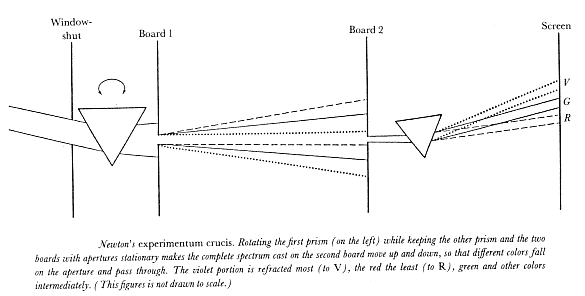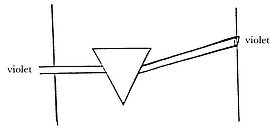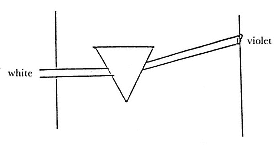5—
A Historical Illustration
So far, I have couched the discussion in terms of making inductions from paltry samples, and that is because induction is the method that Humeans should favor for confirming laws. I think, though, that the process is far better understood as one of deduction; we accept laws on apparently slim experimental bases exactly when we can take for granted such strong background assumptions that (given these assumptions) the data plus the description of the experimental setup deductively imply the law to be established. Probably the most prominent advocate of a deductive method in reasoning from experiment to law is Isaac Newton. I think it will be helpful to look briefly at Newton's use of the "crucial experiment" in his theory of light and colors, and more particularly at Goethe's criticisms of it.
Newton's experimentum crucis is described in his first letter in 1671 to the
Royal Society in which he introduces his theory that white light consists of diverse rays of different refrangibility (that is, they are bent by different amounts when the light passes through a prism) and that color is a property of the ray which depends on its refrangibility. The work reported in the letter is generally taken as a model of scientific reasoning. Thomas Kuhn, for instance, claims that "Newton's experimental documentation of his theory is a classic in its simplicity." According to Kuhn, the opposition view might eventually have accounted for some of the data that appeared to refute it, "but how could they have evaded the implications of the experimentum crucis ? An innovator in the sciences has never stood on surer ground" ("Newton's Optical Papers," in Isaac Newton's Papers and Letters , ed. I. B. Cohen [Cambridge, Mass.: Harvard University Press, 1958], 36).
It is important to keep in mind that Newton believed that his claims were proved by his experiments. He claims "the Theory, which I propounded, was evinced by me, not inferring tis thus because not otherwise, that is, not by deducing it only from a confutation of contrary suppositions but by deriving it from experiments concluding positively and directly." Or, "If the Experiments, which I urge, be defective, it cannot be difficult to show the defects; but if valid, then by proving the theory they must render all objections invalid." One last remark to illustrate the steadfastness of Newton's views on the role of the experimentum crucis in proving this claim appears in Newton's letter of 1676, four years after his initial report to the Royal Society. This letter concerned the difficulties Anthony Lucas had reported in trying to duplicate Newton's experiments and also some of Lucas's own results that contradicted Newton's claims. Newton replies, "Yet it will conduce to his more speedy and full satisfaction if he a little change the method he has propounded, and instead of a multitude of things try only the Experimentum Crucis . For it is not number of experiments, but weight to be regarded; and where one will do, what need many?"
Goethe's point of view is entirely opposite to Newton's: "As worthwhile as each individual experiment may be, it receives its real value only when united or combined with other experiments . . . I would venture to say that we cannot prove anything by one experiment or even several experiments together" ("The Experiment as Mediator between Object and Subject," in Johann Wolfgang von Goethe, Scientific Studies , ed. and tr. Douglas Miller [New York: Suhrkamp, 1988]). For Goethe, all phenomena are connected together, and it is essential to follow through from each experiment to another that "lies next to it or derives directly from it." According to Goethe, "To follow every single experiment through its variations is the real task of the scientific researcher." This is illustrated in his own work in optics where he produces long series of "contiguous" experiments, each of which is suggested by the one before it. The point is not to find some single set of circumstances that are special but rather to lay out all the variations in the phenomena as the circumstances change in a
systematic way. Then one must come to see all the interrelated experiments together and understand them as a whole, "a single piece of experimental evidence explored in its manifold variations."
Goethe is sharp in his criticisms of Newton. Two different kinds of criticism are most relevant here. The first is that Newton's theory fails to account for all the phenomena it should, and that that is no surprise since Newton failed to look at the phenomena under a sufficient range of variation of circumstance. Second, Newton's inferences from the experiments he did make were not valid; the experimentum crucis is a case in point. The chief fault which Goethe finds with Newton's inferences is one that could not arise in Goethe's method. Newton selects a single revealing experiment to theorize from; since he does not see how the phenomena change through Goethe's long sequence of experiments, he does not recognize how variation in circumstance affects the outcome: "[Newton's] chief error consisted in too quickly and hastily setting aside and denying those questions that chiefly relate to whether external conditions cooperate in the appearance of color, without looking more exactly into the proximate circumstances" (Dennis L. Sepper, Goethe contra Newton [Cambridge: Cambridge University Press, 1988], 144).
The crucial experiment involves refracting a beam of light through a prism, which elongates the initial narrow beam and "breaks" it into a colored band—violet at the top, red at the bottom. Then differently colored portions of the elongated beam are refracted through a second prism. Consider diagram 2, which is taken from Dennis L. Sepper's study, Goethe contra Newton . In all cases, the color is preserved, but at one end of the elongated beam the second refracted beam is elongated more than it is at the other. In each case, there is no difference in the way in which the light falls on the prism for the second refraction. Newton immediately concludes, "And so the true cause of the length of the image was detected to be no other than that light consists of rays differently refrangible " (Newton's first letter to the Royal Society, 1671).
We should think about this inference in the context of my earlier cursory description of the modern version of the deductive method, called bootstrapping by Clark Glymour, who has been its champion in recent debates. In the bootstrapping account, we infer from an experimental outcome to a scientific law, as Newton does, but only against a backdrop of rather strong assumptions. Some of these assumptions will be factual ones about the specific arrangements made—for example, that the angle of the prism was 63°; some will be more general claims about how the experimental apparatus works—the theory of condensation in a cloud chamber, for instance; some will be more general claims still—for example, all motions are produced by forces; and some will be metaphysical, such as the "same cause, same effect" principle mentioned in section 3. The same is true of Newton's inference. It may be a perfectly valid inference, but there are repressed premises. It is the repressed premises that Goethe does not like. On Goethe's view of nature, they are not

Diagram 3.2
(From Dennis L. Sepper Goethe contra Newton
[(Cambridge: Cambridge University Press, 1988].)
only badly supported by the evidence; they are false. Colors, like all else in Goethe's world,[10] are a consequence of the action of opposites, in this case light and darkness:
We see on the one side light, the bright; on the other darkness, the dark; we bring what is turbid between the two [such as a prism or a semitransparent sheet of paper], and out of these opposites, with the help of this mediation, there develop, likewise in an opposition, colors. (Theory of Colors , didactic part, paragraph 175)
Newton's argument requires, by contrast, the assumption that the tendency to produce colors is entirely in the nature of the light, and that is why this dispute is of relevance to my point here. As Sepper says, for Newton "the cause is to be sought only in the light itself."
Let us turn to Newton's reasoning. The argument is plausible, so long as one is not looking for deductive certainty. From Newton's point of view (though not from that of Goethe, who imagines a far richer set of possibilities), the two hypotheses to be decided between are: (a) something that happens involving white light in the prism produces colored light; or (b) colored light is already entering the prism in the first place. We can see the force of the argument by thinking in terms of inputs and outputs. Look at what happens to, say, the violet light in the second prism (diagram 3):

Diagram 3.3.
Compare this with the production of violet light in the first prism (diagram 4):

Diagram 3.4.
In both cases, the outputs are the same. The simplest account seems to be that the prism functions in the same way in both cases: it just transports the colored light through, bending it in accord with its fixed degree of refrangibility.
Consider an analogous case. You observe a large, low building. Colored cars drive through. Cars of different colors have different fixed turning radii. You observe for each color that there is a fixed and color-dependent angle between the trajectory on which the car enters the building, and the trajectory on which it exits; moreover, this is just the angle to be expected if the cars were driven through the building with steering wheels locked to the far left. Besides cars, other vehicles enter the building, covered; and each time a covered vehicle enters, a colored car exits shortly afterward. It exits at just that angle that would be appropriate had the original incoming vehicle been a car of the same color driven through with its steering wheel locked. Two hypotheses are offered about what goes on inside the building. Both hypotheses treat the incoming colored cars in the same way: on entering the building, their steering wheels get locked and then they are driven through. The two hypotheses differ, however, about the covered vehicles. The first hypothesis assumes that these, too, are colored cars. Inside the building they get unwrapped, and then they are treated just like all the other colored cars. The second hypothesis is more ambitious. It envisages that the low building contains an entire car factory. The covered vehicles contain raw material, and inside the building there are not only people who lock steering wheels, but a whole crew of Fiat workers and machinery turning raw materials into cars.
Obviously, the first hypothesis is simpler, but it has more in its favor than that. For so far, the second hypothesis has not explained why the manufactured cars exit at the angle they do, relative to their incoming raw materials; and there seems to be no immediate natural account to give on the second story. True, the cars are manufactured with fixed turning radii, but why should they leave the factory at just the same angle relative to the cart that carries in their raw materials as a drive-through does relative to its line of entry? After all, the manufactured car has come to exist only somewhere within the factory, and even if its steering wheel is locked, it seems a peculiar coincidence should that result in just the right exit point to yield the required angle vis-à-vis the raw materials. In this case, barring other information, the first, Newtonian, hypothesis seems the superior. The caveat, "barring other information," is central, of course, to Goethe's attack. For, as I have already remarked, Goethe was appalled at the small amount of information that Newton collected, and he argued that Newton's claim was in no way adequate to cover the totality of the phenomena. What looks to be the best hypothesis in a single case can certainly look very different when a whole array of different cases have to be considered.
The principal point to notice, for my purpose, is that the argument is not at all deductive. It can only become so if we already presuppose that we are looking for some fixed feature in light itself that will account for what comes
out of the prism—something, as I would say, in the nature of light. Any assumption like this is deeply contrary to Goethe's point of view. The first few paragraphs of Newton's letter, before the introduction of the crucial experiment, give some grounds for such an assumption on his part; Goethe makes fun of them:
It is a fact that under those circumstances that Newton exactly specifies, the image of the sun is five times as long as it is wide, and that this elongated image appears entirely in colors. Every observer can repeatedly witness this phenomenon without any great effort.
Newton himself tells us how he went to work in order to convince himself that no external cause can bring this elongation and coloration of the image. This treatment of his will, as already was mentioned above, be subjected to criticism for we can raise many questions and investigate with exactness, whether he went to work properly and to what extent his proof is in every sense complete.
If one analyzes his reasons, they have the following form:
When the ray is refracted the image is longer than it should be according to the laws of refraction.
Now I have tried everything and thereby convinced myself that no external cause is responsible for this elongation.
Therefore it is an inner cause, and this we find in the divisibility of light. For since it takes up a larger space than before, it must divided, thrown asunder; and since we see the sundered light in colors, the different parts of it must be colored.
How much there is to object to immediately in this rationale! [Goethe, 1793; quoted from Sepper, p. 101]
The contrast that I want to highlight is between Newton's postulation of an inner cause in light versus Goethe's long and many-faceted row of experiments. Goethe often remarks that he and Newton both claim to be concerned with colors ; Newton after all labels his account in the 1671 letter his "new theory of light and colors." But, in actuality, Goethe points out, Newton's work is almost entirely about the behavior of rays—that is, about the inner nature of light. Goethe's experiments often involve light, but it is not light that he studies. The experiments describe entire interacting complexes, such as evening light entering a room through a hole in a white blind on which a candle throws light ("snow seen through the opening will then appear perfectly blue, because the paper is tinged with warm yellow by the candlelight" [Theory of Colors , didactic part, paragraph 79]), or sunlight shining into a diving bell (in this case "everything is seen in a red light . . . while the shadows appear green" [Theory of Colors , didactic part, paragraph 78]), or a particularly exemplary case for the existence of colored shadows, a pencil placed on a sheet of white paper between a short, lighted candle and a window so that the twilight from the window illuminates the pencil's shadow from the candle ("the shadow will appear of the most beautiful blue" [Theory of Colors , didactic part, paragraph 65]). Even when described from the point of view of Goethe's final account of color forma-
tion, in the prism experiments Goethe is not looking at light but rather at light (or darkness) -in-interaction-with-a-turbid-medium.
Newton focuses on his one special experiment and maintains that the account of the phenomena in that experiment will pinpoint an explanation that is generalizable. The feature that explains the phenomena in that situation will explain phenomena in other situations; hence he looks to a feature that is part of the inner constitution of light itself. To place it in the inner constitution is to cast it not as an observable property characteristic of light but rather as a power that reveals itself, if at all, in appropriately structured circumstances. To describe it as part of light's constitution is to ascribe a kind of permanence to the association: light retains this power across a wide variation in circumstance—indeed, probably so long as it remains light. That is, I maintain, to treat it as an Aristotelian-style nature. This is why Newton, unlike Goethe, can downplay the experimental context. The context is there to elicit the nature of light; it is not an essential ingredient in the ultimate structure of the phenomenon.